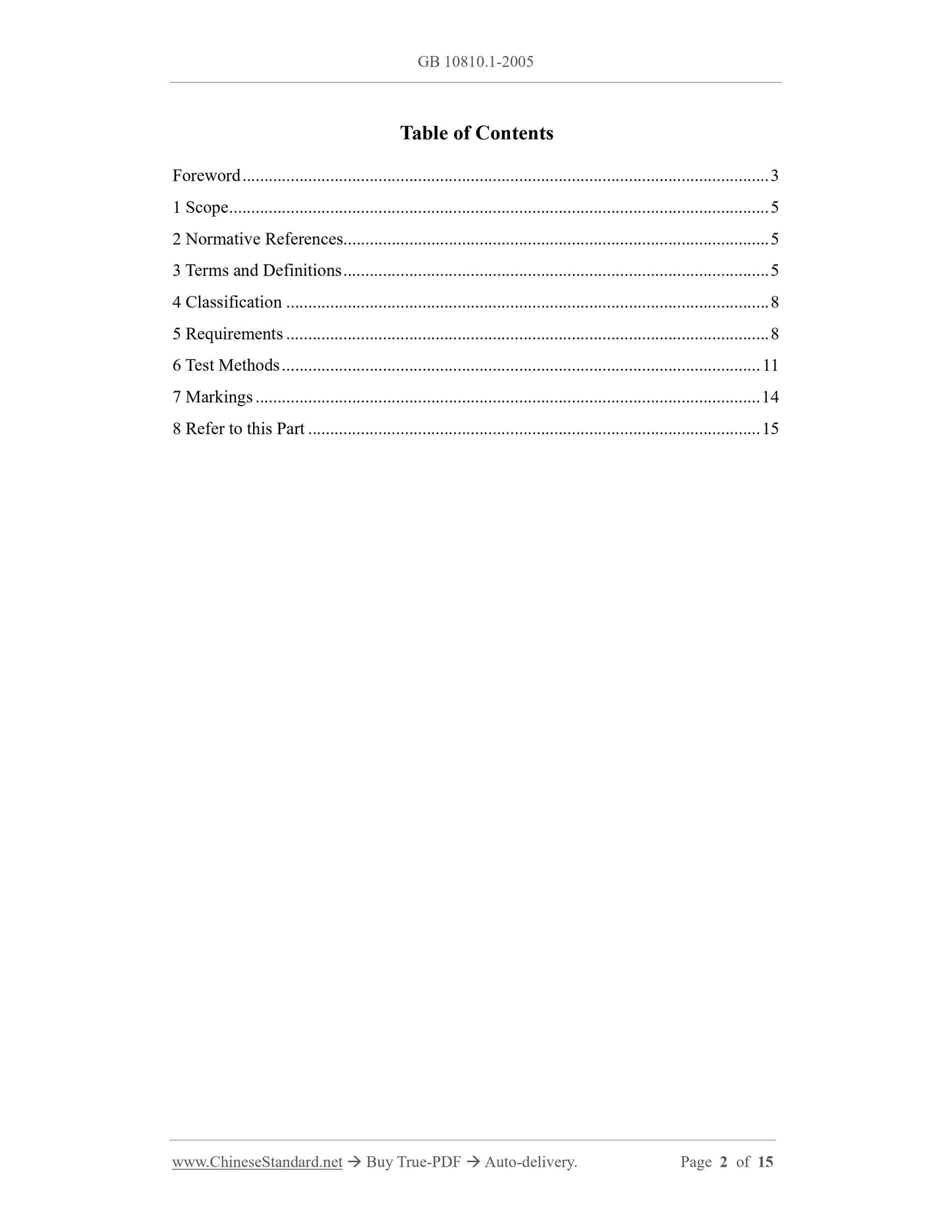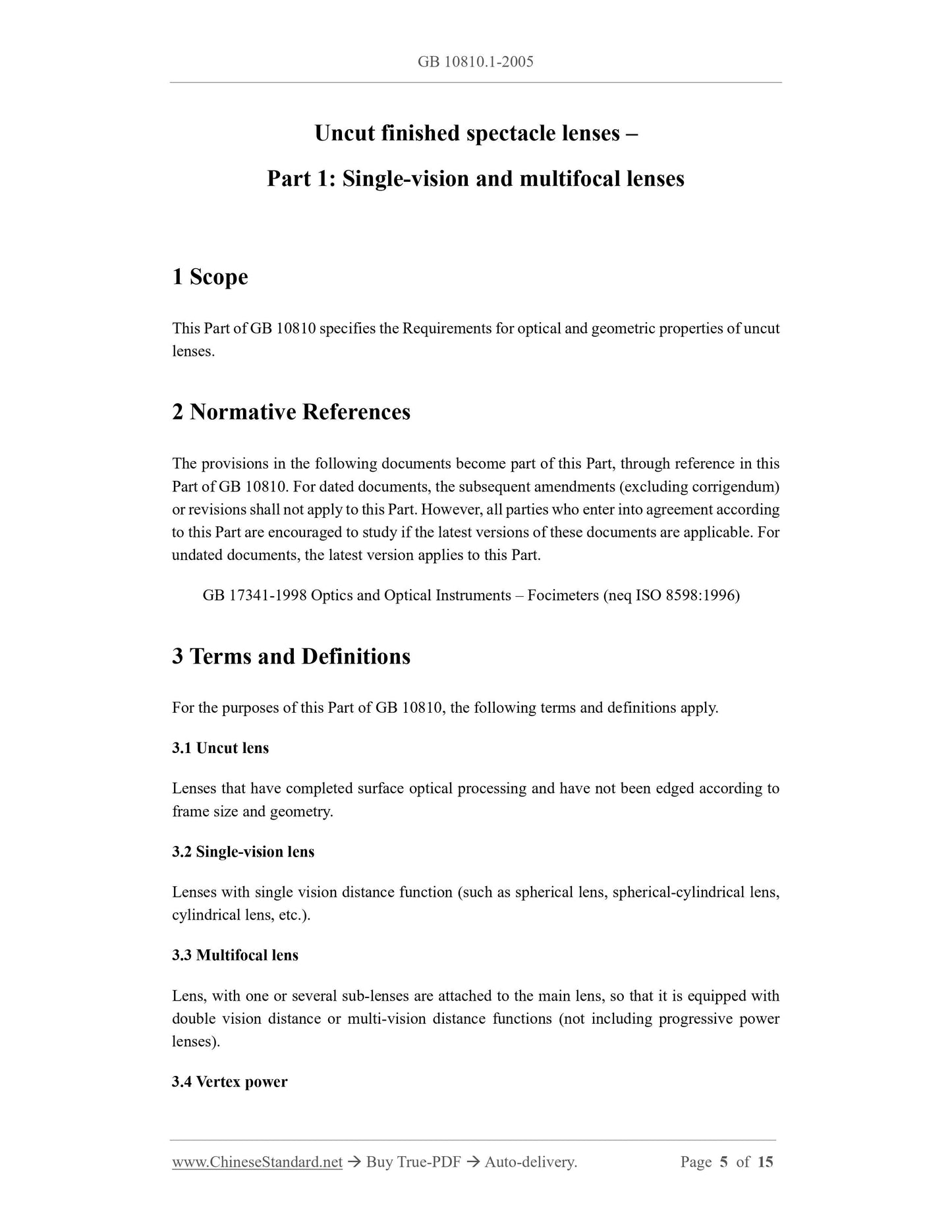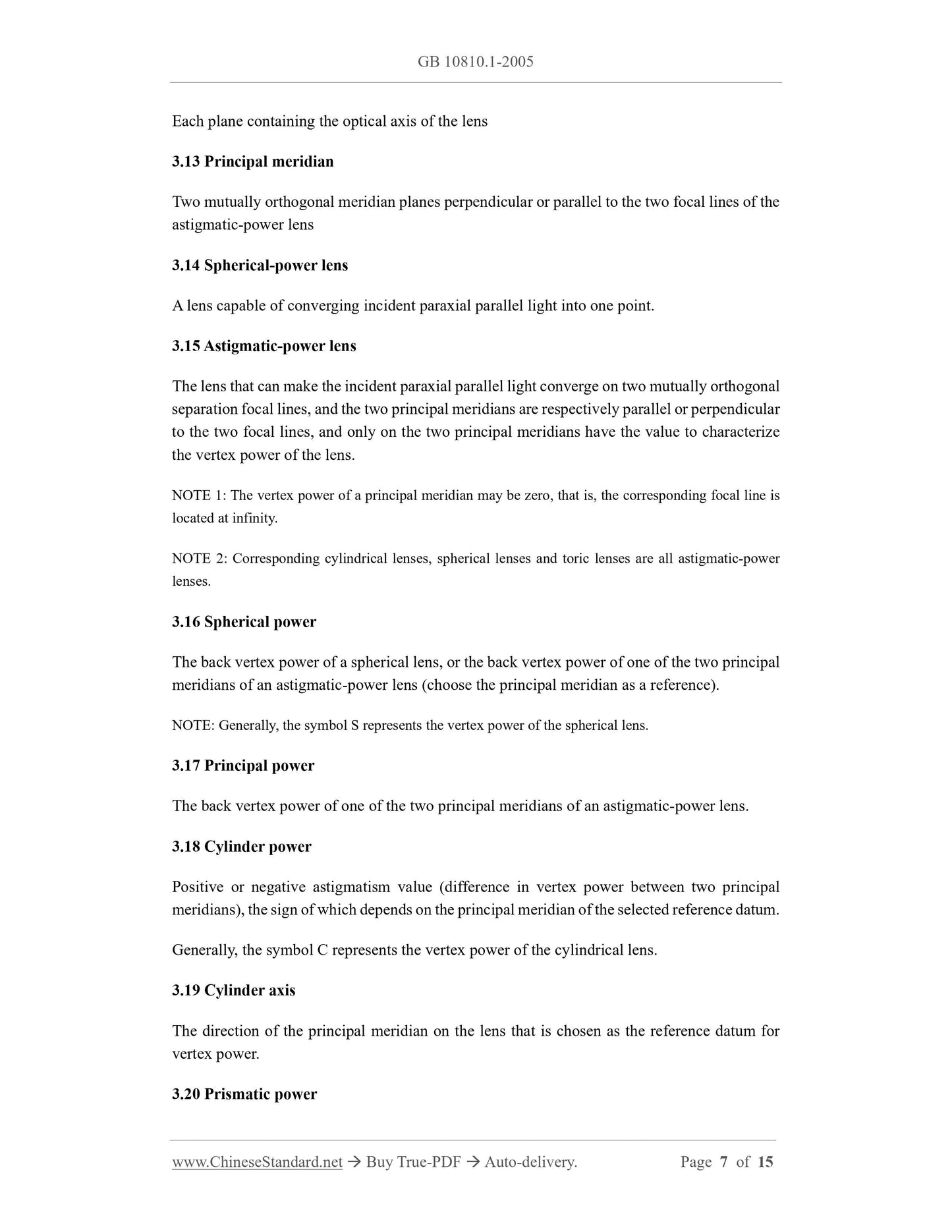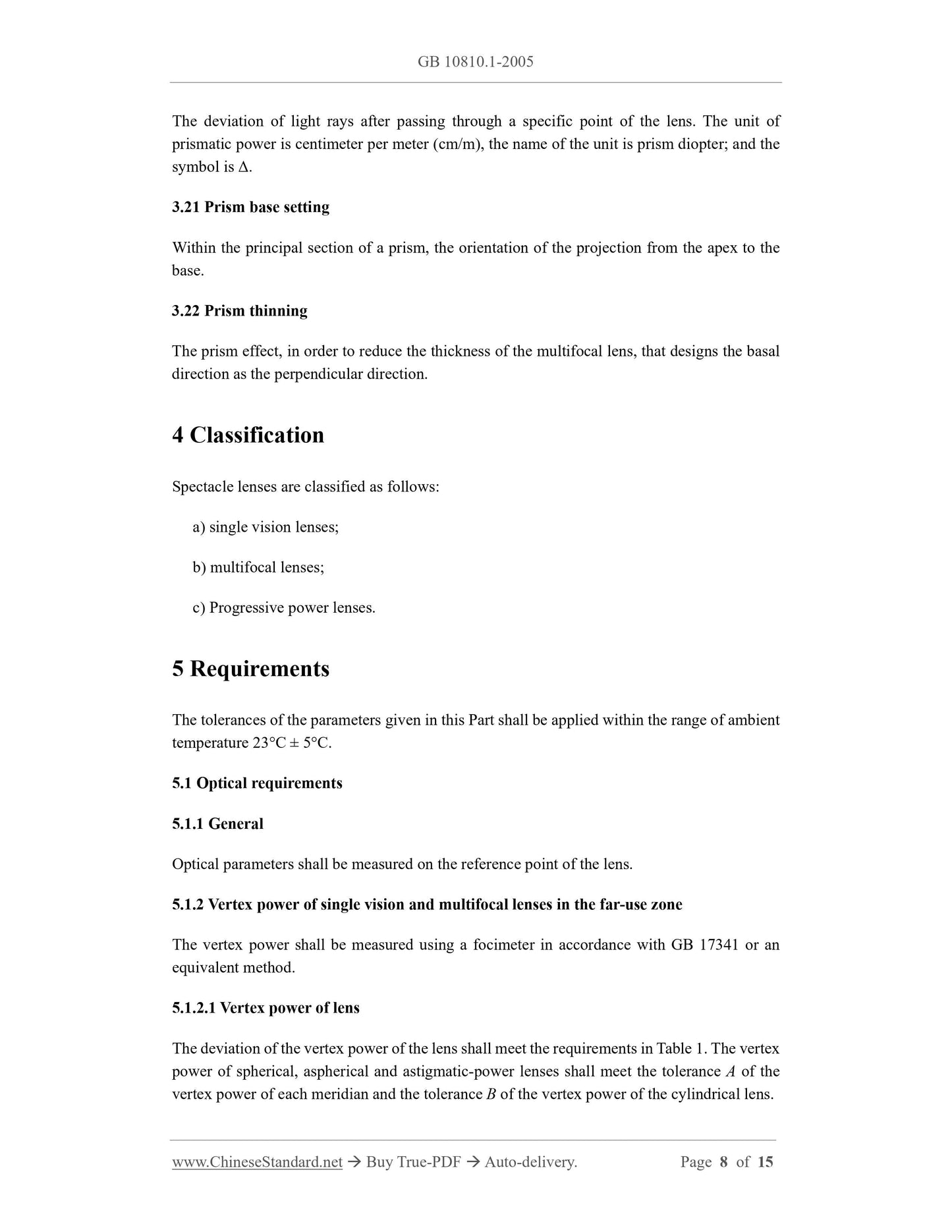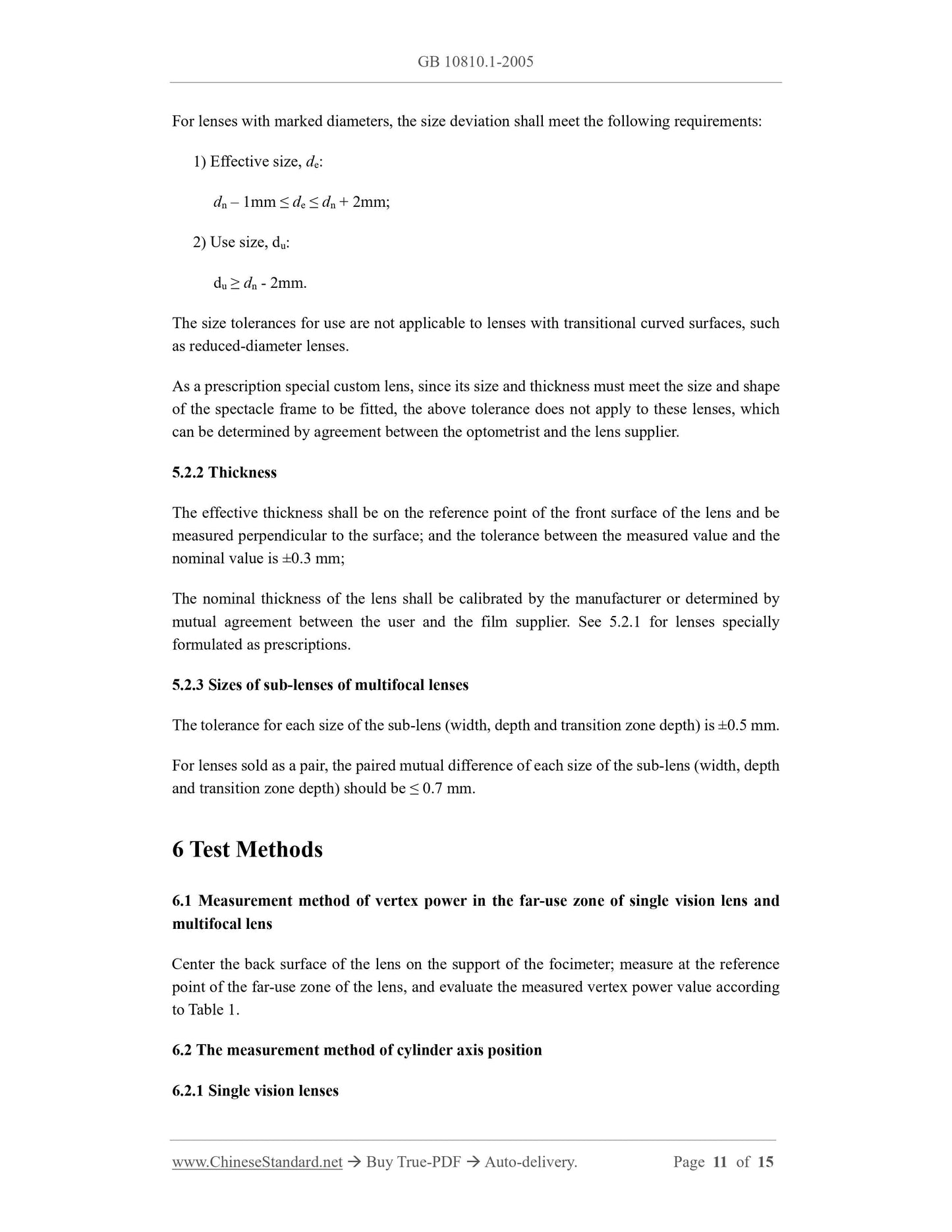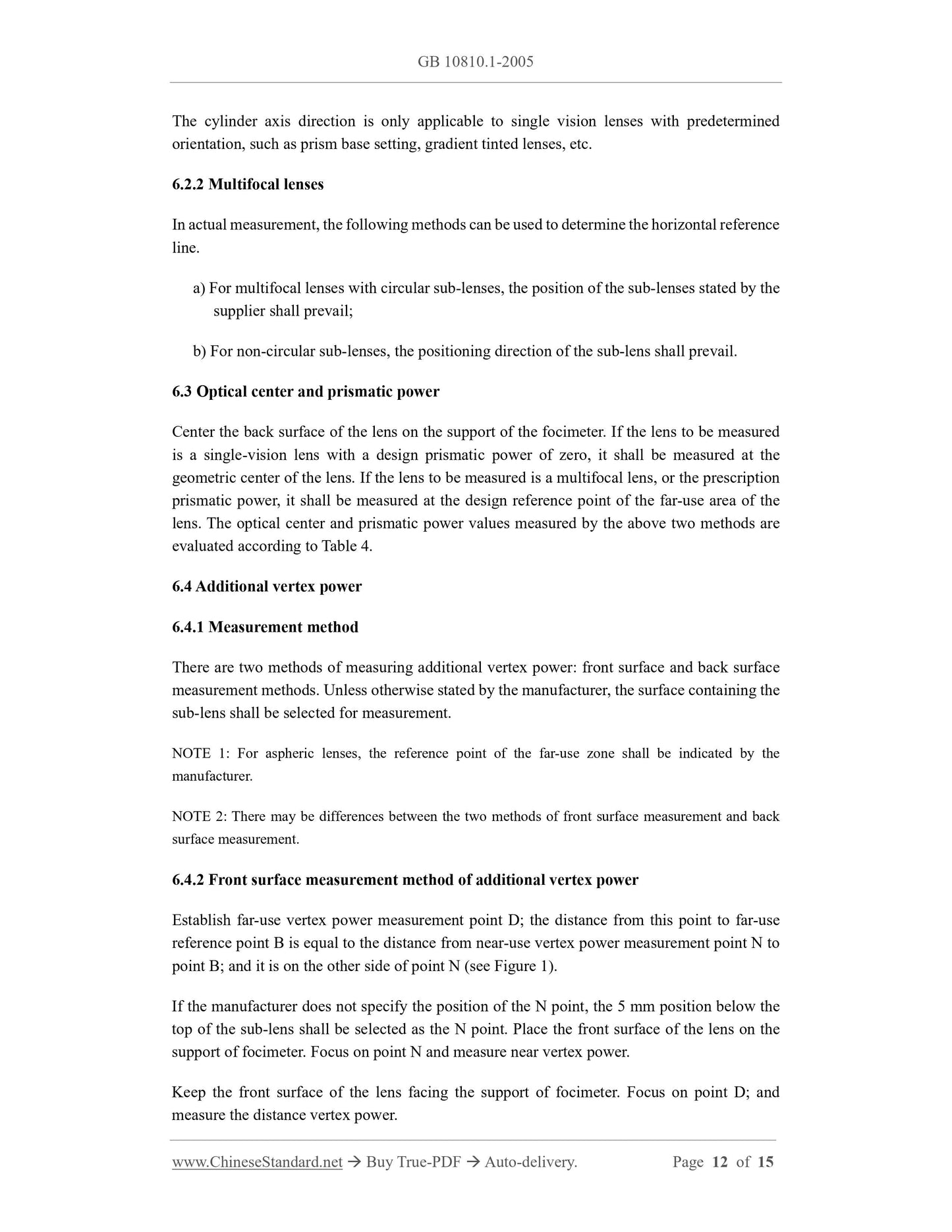1
/
de
7
PayPal, credit cards. Download editable-PDF & invoice in 1 second!
GB 10810.1-2005 English PDF (GB10810.1-2005)
GB 10810.1-2005 English PDF (GB10810.1-2005)
Prix habituel
$105.00 USD
Prix habituel
Prix promotionnel
$105.00 USD
Prix unitaire
/
par
Frais d'expédition calculés à l'étape de paiement.
Impossible de charger la disponibilité du service de retrait
Delivery: 3 seconds. Download true-PDF + Invoice.
Get QUOTATION in 1-minute: Click GB 10810.1-2005
Historical versions: GB 10810.1-2005
Preview True-PDF (Reload/Scroll if blank)
GB 10810.1-2005: Uncut finished spectacle lenses -- Part 1: Single-vision and multifocal lenses
GB 10810.1-2005
GB
NATIONAL STANDARD OF THE
PEOPLE’S REPUBLIC OF CHINA
ICS 11.040.70
Y 89
Replacing GB 10810-1996
Uncut finished spectacle lenses –
Part 1: Single-vision and multifocal lenses
(ISO 8980-1:2004, Ophthalmic Optics - Uncut Finished Spectacle Lenses –
Part 1: Specification for Single-Vision and Multifocal Lenses, MOD)
ISSUED ON: NOVEMBER 14, 2005
IMPLEMENTED ON: MAY 01, 2006
Issued by: General Administration of Quality Supervision, Inspection and
Quarantine;
Standardization Administration of the People’s Republic of China.
Table of Contents
Foreword ... 3
1 Scope ... 5
2 Normative References ... 5
3 Terms and Definitions ... 5
4 Classification ... 8
5 Requirements ... 8
6 Test Methods ... 11
7 Markings ... 14
8 Refer to this Part ... 15
Uncut finished spectacle lenses –
Part 1: Single-vision and multifocal lenses
1 Scope
This Part of GB 10810 specifies the Requirements for optical and geometric properties of uncut
lenses.
2 Normative References
The provisions in the following documents become part of this Part, through reference in this
Part of GB 10810. For dated documents, the subsequent amendments (excluding corrigendum)
or revisions shall not apply to this Part. However, all parties who enter into agreement according
to this Part are encouraged to study if the latest versions of these documents are applicable. For
undated documents, the latest version applies to this Part.
GB 17341-1998 Optics and Optical Instruments – Focimeters (neq ISO 8598:1996)
3 Terms and Definitions
For the purposes of this Part of GB 10810, the following terms and definitions apply.
3.1 Uncut lens
Lenses that have completed surface optical processing and have not been edged according to
frame size and geometry.
3.2 Single-vision lens
Lenses with single vision distance function (such as spherical lens, spherical-cylindrical lens,
cylindrical lens, etc.).
3.3 Multifocal lens
Lens, with one or several sub-lenses are attached to the main lens, so that it is equipped with
double vision distance or multi-vision distance functions (not including progressive power
lenses).
3.4 Vertex power
Each plane containing the optical axis of the lens
3.13 Principal meridian
Two mutually orthogonal meridian planes perpendicular or parallel to the two focal lines of the
astigmatic-power lens
3.14 Spherical-power lens
A lens capable of converging incident paraxial parallel light into one point.
3.15 Astigmatic-power lens
The lens that can make the incident paraxial parallel light converge on two mutually orthogonal
separation focal lines, and the two principal meridians are respectively parallel or perpendicular
to the two focal lines, and only on the two principal meridians have the value to characterize
the vertex power of the lens.
NOTE 1: The vertex power of a principal meridian may be zero, that is, the corresponding focal line is
located at infinity.
NOTE 2: Corresponding cylindrical lenses, spherical lenses and toric lenses are all astigmatic-power
lenses.
3.16 Spherical power
The back vertex power of a spherical lens, or the back vertex power of one of the two principal
meridians of an astigmatic-power lens (choose the principal meridian as a reference).
NOTE: Generally, the symbol S represents the vertex power of the spherical lens.
3.17 Principal power
The back vertex power of one of the two principal meridians of an astigmatic-power lens.
3.18 Cylinder power
Positive or negative astigmatism value (difference in vertex power between two principal
meridians), the sign of which depends on the principal meridian of the selected reference datum.
Generally, the symbol C represents the vertex power of the cylindrical lens.
3.19 Cylinder axis
The direction of the principal meridian on the lens that is chosen as the reference datum for
vertex power.
3.20 Prismatic power
The deviation of light rays after passing through a specific point of the lens. The unit of
prismatic power is centimeter per meter (cm/m), the name of the unit is prism diopter; and the
symbol is Δ.
3.21 Prism base setting
Within the principal section of a prism, the orientation of the projection from the apex to the
base.
3.22 Prism thinning
The prism effect, in order to reduce the thickness of the multifocal lens, that designs the basal
direction as the perpendicular direction.
4 Classification
Spectacle lenses are classified as follows:
a) single vision lenses;
b) multifocal lenses;
c) Progressive power lenses.
5 Requirements
The tolerances of the parameters given in this Part shall be applied within the range of ambient
temperature 23°C ± 5°C.
5.1 Optical requirements
5.1.1 General
Optical parameters shall be measured on the reference point of the lens.
5.1.2 Vertex power of single vision and multifocal lenses in the far-use zone
The vertex power shall be measured using a focimeter in accordance with GB 17341 or an
equivalent method.
5.1.2.1 Vertex power of lens
The deviation of the vertex power of the lens shall meet the requirements in Table 1. The vertex
power of spherical, aspherical and astigmatic-power lenses shall meet the tolerance A of the
vertex power of each meridian and the tolerance B of the vertex power of the cylindrical lens.
For lenses with marked diameters, the size deviation shall meet the following requirements:
1) Effective size, de:
dn – 1mm ≤ de ≤ dn + 2mm;
2) Use size, du:
du ≥ dn - 2mm.
The size tolerances for use are not applicable to lenses with transitional curved surfaces, such
as reduced-diameter lenses.
As a prescription special custom lens, since its size and thickness must meet the size and shape
of the spectacle frame to be fitted, the above tolerance does not apply to these lenses, which
can be determined by agreement between the optometrist and the lens supplier.
5.2.2 Thickness
The effective thickness shall be on the reference point of the front surface of the lens and be
measured perpendicular to the surface; and the tolerance between the measured value and the
nominal value is ±0.3 mm;
The nominal thickness of the lens shall be calibrated by the manufacturer or determined by
mutual agreement between the user and the film supplier. See 5.2.1 for lenses specially
formulated as prescriptions.
5.2.3 Sizes of sub-lenses of multifocal lenses
The tolerance for each size of the sub-lens (width, depth and transition zone depth) is ±0.5 mm.
For lenses sold as a pair, the paired mutual difference of each size of the sub-lens (width, depth
and transition zone depth) should be ≤ 0.7 mm.
6 Test Methods
6.1 Measurement method of vertex power in the far-use zone of single vision lens and
multifocal lens
Center the back surface of the lens on the support of the focimeter; measure at the reference
point of the far-use zone of the lens, and evaluate the measured vertex power value according
to Table 1.
6.2 The measurement method of cylinder axis position
6.2.1 Single vision lenses
The cylinder axis direction is only applicable to single vision lenses with predetermined
orientation, such as prism base setting, gradient tinted lenses, etc.
6.2.2 Multifocal lenses
In actual measurement, the following methods can be used to determine the horizontal reference
line.
a) For multifocal lenses with circular sub-lenses, the position of the sub-lenses stated by the
supplier shall prevail;
b) For n...
Get QUOTATION in 1-minute: Click GB 10810.1-2005
Historical versions: GB 10810.1-2005
Preview True-PDF (Reload/Scroll if blank)
GB 10810.1-2005: Uncut finished spectacle lenses -- Part 1: Single-vision and multifocal lenses
GB 10810.1-2005
GB
NATIONAL STANDARD OF THE
PEOPLE’S REPUBLIC OF CHINA
ICS 11.040.70
Y 89
Replacing GB 10810-1996
Uncut finished spectacle lenses –
Part 1: Single-vision and multifocal lenses
(ISO 8980-1:2004, Ophthalmic Optics - Uncut Finished Spectacle Lenses –
Part 1: Specification for Single-Vision and Multifocal Lenses, MOD)
ISSUED ON: NOVEMBER 14, 2005
IMPLEMENTED ON: MAY 01, 2006
Issued by: General Administration of Quality Supervision, Inspection and
Quarantine;
Standardization Administration of the People’s Republic of China.
Table of Contents
Foreword ... 3
1 Scope ... 5
2 Normative References ... 5
3 Terms and Definitions ... 5
4 Classification ... 8
5 Requirements ... 8
6 Test Methods ... 11
7 Markings ... 14
8 Refer to this Part ... 15
Uncut finished spectacle lenses –
Part 1: Single-vision and multifocal lenses
1 Scope
This Part of GB 10810 specifies the Requirements for optical and geometric properties of uncut
lenses.
2 Normative References
The provisions in the following documents become part of this Part, through reference in this
Part of GB 10810. For dated documents, the subsequent amendments (excluding corrigendum)
or revisions shall not apply to this Part. However, all parties who enter into agreement according
to this Part are encouraged to study if the latest versions of these documents are applicable. For
undated documents, the latest version applies to this Part.
GB 17341-1998 Optics and Optical Instruments – Focimeters (neq ISO 8598:1996)
3 Terms and Definitions
For the purposes of this Part of GB 10810, the following terms and definitions apply.
3.1 Uncut lens
Lenses that have completed surface optical processing and have not been edged according to
frame size and geometry.
3.2 Single-vision lens
Lenses with single vision distance function (such as spherical lens, spherical-cylindrical lens,
cylindrical lens, etc.).
3.3 Multifocal lens
Lens, with one or several sub-lenses are attached to the main lens, so that it is equipped with
double vision distance or multi-vision distance functions (not including progressive power
lenses).
3.4 Vertex power
Each plane containing the optical axis of the lens
3.13 Principal meridian
Two mutually orthogonal meridian planes perpendicular or parallel to the two focal lines of the
astigmatic-power lens
3.14 Spherical-power lens
A lens capable of converging incident paraxial parallel light into one point.
3.15 Astigmatic-power lens
The lens that can make the incident paraxial parallel light converge on two mutually orthogonal
separation focal lines, and the two principal meridians are respectively parallel or perpendicular
to the two focal lines, and only on the two principal meridians have the value to characterize
the vertex power of the lens.
NOTE 1: The vertex power of a principal meridian may be zero, that is, the corresponding focal line is
located at infinity.
NOTE 2: Corresponding cylindrical lenses, spherical lenses and toric lenses are all astigmatic-power
lenses.
3.16 Spherical power
The back vertex power of a spherical lens, or the back vertex power of one of the two principal
meridians of an astigmatic-power lens (choose the principal meridian as a reference).
NOTE: Generally, the symbol S represents the vertex power of the spherical lens.
3.17 Principal power
The back vertex power of one of the two principal meridians of an astigmatic-power lens.
3.18 Cylinder power
Positive or negative astigmatism value (difference in vertex power between two principal
meridians), the sign of which depends on the principal meridian of the selected reference datum.
Generally, the symbol C represents the vertex power of the cylindrical lens.
3.19 Cylinder axis
The direction of the principal meridian on the lens that is chosen as the reference datum for
vertex power.
3.20 Prismatic power
The deviation of light rays after passing through a specific point of the lens. The unit of
prismatic power is centimeter per meter (cm/m), the name of the unit is prism diopter; and the
symbol is Δ.
3.21 Prism base setting
Within the principal section of a prism, the orientation of the projection from the apex to the
base.
3.22 Prism thinning
The prism effect, in order to reduce the thickness of the multifocal lens, that designs the basal
direction as the perpendicular direction.
4 Classification
Spectacle lenses are classified as follows:
a) single vision lenses;
b) multifocal lenses;
c) Progressive power lenses.
5 Requirements
The tolerances of the parameters given in this Part shall be applied within the range of ambient
temperature 23°C ± 5°C.
5.1 Optical requirements
5.1.1 General
Optical parameters shall be measured on the reference point of the lens.
5.1.2 Vertex power of single vision and multifocal lenses in the far-use zone
The vertex power shall be measured using a focimeter in accordance with GB 17341 or an
equivalent method.
5.1.2.1 Vertex power of lens
The deviation of the vertex power of the lens shall meet the requirements in Table 1. The vertex
power of spherical, aspherical and astigmatic-power lenses shall meet the tolerance A of the
vertex power of each meridian and the tolerance B of the vertex power of the cylindrical lens.
For lenses with marked diameters, the size deviation shall meet the following requirements:
1) Effective size, de:
dn – 1mm ≤ de ≤ dn + 2mm;
2) Use size, du:
du ≥ dn - 2mm.
The size tolerances for use are not applicable to lenses with transitional curved surfaces, such
as reduced-diameter lenses.
As a prescription special custom lens, since its size and thickness must meet the size and shape
of the spectacle frame to be fitted, the above tolerance does not apply to these lenses, which
can be determined by agreement between the optometrist and the lens supplier.
5.2.2 Thickness
The effective thickness shall be on the reference point of the front surface of the lens and be
measured perpendicular to the surface; and the tolerance between the measured value and the
nominal value is ±0.3 mm;
The nominal thickness of the lens shall be calibrated by the manufacturer or determined by
mutual agreement between the user and the film supplier. See 5.2.1 for lenses specially
formulated as prescriptions.
5.2.3 Sizes of sub-lenses of multifocal lenses
The tolerance for each size of the sub-lens (width, depth and transition zone depth) is ±0.5 mm.
For lenses sold as a pair, the paired mutual difference of each size of the sub-lens (width, depth
and transition zone depth) should be ≤ 0.7 mm.
6 Test Methods
6.1 Measurement method of vertex power in the far-use zone of single vision lens and
multifocal lens
Center the back surface of the lens on the support of the focimeter; measure at the reference
point of the far-use zone of the lens, and evaluate the measured vertex power value according
to Table 1.
6.2 The measurement method of cylinder axis position
6.2.1 Single vision lenses
The cylinder axis direction is only applicable to single vision lenses with predetermined
orientation, such as prism base setting, gradient tinted lenses, etc.
6.2.2 Multifocal lenses
In actual measurement, the following methods can be used to determine the horizontal reference
line.
a) For multifocal lenses with circular sub-lenses, the position of the sub-lenses stated by the
supplier shall prevail;
b) For n...
Share

